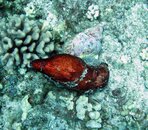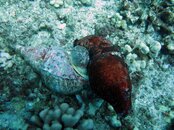I organized a survey of the north Pacific from Hawaii to Palau, and the Northern Marianas Islands to Kapingimarangi. The expedition was supported by the U.S. Department of the Interior and managed by Westighouse Ocean Research Laboratories. I headed a team of 69 diver/scientists that were divided into groups of 10 and sent out to survey conditions in as many locations as possible.
We found other infestations of crown of thorns starfish in different stages of development in many island areas - usually in close proximity to villages or urban areas. There was no "common denominator" to clarify the cause of the population blooms. Instead, the picture that emerged was that blooms are likely to occur where the reefs are stressed. And the reefs of the world are stressed by many different causes.
...
And then there is the triton. The beautiful triton.
Bob Endean said, right away, that he thought that the cause of the starfish explosion was because the tritons were overcollected. Other biologists, including me, thought this unlikely. But now, after investigating the infestations nearly 30 years, I think Bob was right after all. Or partly right. Certainly the tritons are the major predator on the starfish. And they are overcollected, even endangered or locally extinct, in most areas of the Pacific.
There may be many contributing causes of the infestations. Like cancer. But the plight of the triton is symmetrically balanced with the escalation of starfish numbers.
Everybody loves the triton. Or at least they love its shell. People make horns, bookends, door stops, or just decorations of these glorious shells. They sell for as much as $100 for a nice one, sometimes more. Virtually every single island diver, man, woman or child, grabs every single triton they see. A multitude of recreational and professional skin and SCUBA divers grab every one, regardless of size, sometimes just happening across one, sometimes avidly seeking them out.
Tritons normally come out to feed at night. Just as the Crown of Thorns normally feeds at night. These days, most island spear fishers also go out at night and underwater flashlights are found in the smallest island village stores.
They are not hard to see, either. Even small tritons stand out sharply against the background of a coral reef. Glorious colors and graceful shape.
In Florida, at a "Shell Factory" I found thousands of tritons from all over the Pacific. From tiny little ones only as long as my thumb to big ones the size of my forearm.





